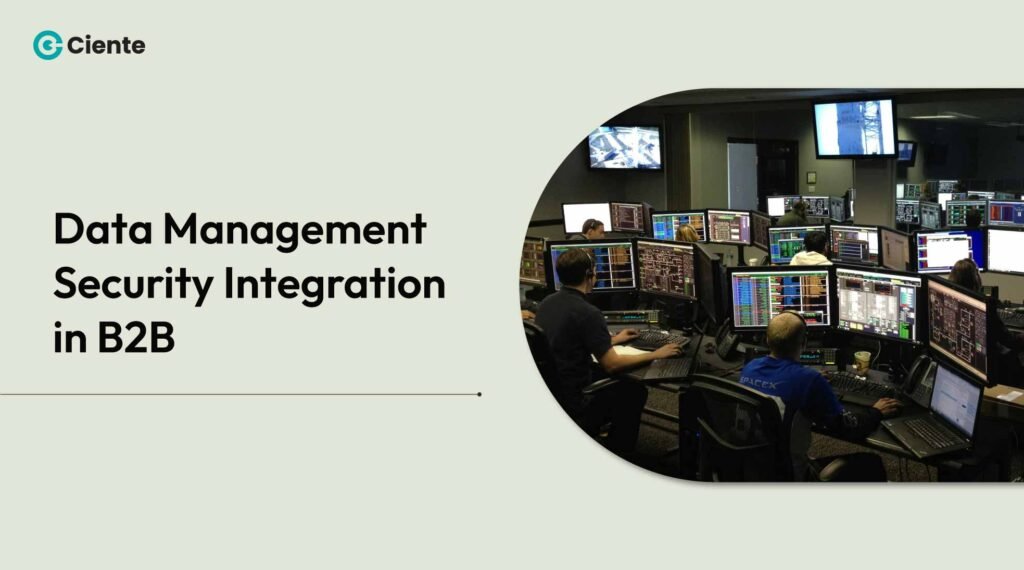Data is everywhere and in large volumes- If not safeguarded, your valuable information is at risk. How can you employ effective data security practices?
Accurate data is the foundation of informed decision-making. B2B companies generate and store massive amounts of information. Although online data access has streamlined daily operations, it is associated with substantial risks. The frequency of cyber-attacks has increased in recent times, highlighting the need for enhanced data management security measures.
Data management security stands as a fundamental trust factor for B2B brands. This approach allows them to comply with industry regulatory requirements. Businesses now need to handle both the quantity and variety of collected data along with understanding its interactions to maintain security. Organizations face significant risks when failing to protect their data because the exposure leads to financial penalties and legal consequences. Moreover, it threatens customer trust and loyalty, which are critical in B2B relationships.
In this blog, we have covered data management security principles, illustrated its importance, how it operates, and listed best practices for data protection.
What is Data Management Security?
Data security is a top priority for companies in business-to-business (B2B) settings because they extensively handle sensitive customer data alongside intellectual property and financial records. With the right knowledge and tools, B2B brands can meet security and compliance requirements.
Data management security encompasses the procedures and technological solutions used to defend data against unauthorized access and prevent corruption or theft during its entire life span. It ensures secure data storage and restricts access to authorized individuals while processing data in compliance with regulatory and industry standards. Data management security focuses on maintaining data integrity while ensuring confidentiality and availability protection. The objective is to protect data against unauthorized access and modification while ensuring organizational access when necessary. Modern organizations must prioritize data protection because data breaches and cyber-attacks can destroy company operations and damage reputations.
With data management security, brands can protect against hackers and internal threats. Data risks may stem from employee mistakes or accidental deletions with poor handling from both internal staff and external vendors. To ensure data remains protected, organizations must develop a strong security strategy that includes multiple layers of protection covering secure storage facilities access control mechanisms, and consistent audit processes.
Data management Security- Benefits
Data management security represents a comprehensive protection strategy that combines multiple technical, organizational, and procedural measures to reduce risks while securing valuable data assets. It holds essential importance for multiple reasons, especially for B2B brands that maintain sensitive business and customer information. Implementing data management security is important because B2B brands routinely manage sensitive business and customer information. Marketers must prioritize data security, given the day and age of the tech revolution.
Protecting Sensitive Information
B2B brands maintain extensive databases of confidential information which include customer contact details alongside proprietary business strategies. A data breach can cause substantial monetary damages plus legal penalties and diminished customer confidence. Business continuity and reputation maintenance depends on protecting data against unauthorized access and cyberattacks and fulfilling legal requirements.
Compliance with Legal and Industry Regulations
Businesses need to follow multiple legal requirements regarding data management and protection because data privacy laws like GDPR in Europe and CCPA in California with other regional regulations, are becoming more stringent. Companies that ignore these regulations risk facing significant fines together with potential lasting damage to their brand reputation. Through data management security, your company maintains compliance and prevents unnecessary non-compliance risks.
Mitigating Financial and Reputational Damage
Data breaches can have devastating financial consequences. When a breach occurs, businesses face upfront costs such as recovery and notification expenses and regulatory fines. The harm from reputational damage after a security incident exceeds other forms. Both customers and partners expect reliable protection for their sensitive information. Trust violations between businesses and their partners can lead to lost business opportunities while weakening long-term relationships.
Preventing Business Disruption
Business operation downtime can occur from data breaches or losses, which also cause essential systems to become inaccessible and interrupt services. Any temporary disruption within B2B settings that depends on seamless data exchange between parties produces effects that damage both your company and its clients. Data management security that works well, reduces disruption risks while maintaining smooth operations and client satisfaction.
Building Trust with Partners and Customers
B2B companies frequently share sensitive data with entities like suppliers and business partners. Businesses that enforce strong data security protocols establish trustworthiness with their external stakeholders. The foundation of B2B relationships rests on trust while showing dedication to data security reveals your priority for safeguarding sensitive information.
Data Management Security: The Functioning
Data management security utilizes multiple strategies and technologies along with best practices to defend data against threats from both inside and outside an organization. We can analyze how data management security functions in B2B settings by examining its fundamental components.
1. Data Classification and Categorization
Establishing an effective data security strategy begins with the classification and categorization of the company’s data. Not all data is equally sensitive. Financial records, including intellectual property and customer data, need stronger protection than general operational data. Data categorization enables organizations to implement security measures that match the specific sensitivity and value. This strategy ensures efficient resource allocation and maximum security protection for critical data.
2. Access Control and User Authentication
The foundational principle of data management security revolves around granting sensitive data access exclusively to authorized people. Implementing strong access control measures is essential. Multi-factor authentication requires users to supply extra credentials, such as a verification code sent via phone, that ensure security beyond standard password protection.
3. Encryption
Encryption stands as a crucial protective method for securing data that remains stored as well as data that moves across networks. The encryption process maintains data security by keeping intercepted information unreadable without access to the correct decryption key. B2B brands must use encryption to secure sensitive data during exchanges. The strategy shields against unauthorized entry and lowers the risk of data exposure during security incidents.
4. Data Backup and Recovery
A comprehensive data management security plan requires an effective backup and recovery strategy for completeness. Data loss can result from accidental file deletion alongside hardware malfunctions and cyber threats like ransomware attacks. Safe storage of your periodic data backups enables recovery of lost information after a disaster. The recovery plan must include detailed steps for restoring access to vital systems and data while reducing downtime and business disruption.
5. Auditing and Monitoring
The regular surveillance and auditing of data access patterns helps organizations spot abnormal activities that may indicate security breaches at an early stage. Security information and event management (SIEM) tools with intrusion detection systems (IDS) track user actions and alert administrators about suspicious activities whenever unexpected events take place. Regular audits provide compliance assurance while offering insights about your data security effectiveness.
6. Data Masking
Occasionally, businesses must share information for analysis and processing purposes but without revealing private details. Data masking and tokenization serve as methods that protect sensitive information while permitting its usage for intended purposes. Data masking creates fictional data similar to real data, while tokenization replaces sensitive information with random tokens that require original data to be decoded.
7. Employee Training and Awareness
Data breaches most frequently occur because of human error. Employees can unintentionally reveal data by using weak passwords or sending sensitive information to the wrong people while falling victim to phishing scams. Consistent training sessions and awareness programs play a crucial role in helping your team recognize data security risks and adopt best data protection practices. The training should cover guidelines for building strong passwords alongside methods for identifying phishing attacks and proper handling of sensitive data.
Best Practices for successful data security and management
After mastering the basics of data management security, let’s explore the best practices for B2B brands to improve their data security measures.
Make Data Security a Top Priority
Leadership must establish data security as a top organizational priority at all levels. Senior executives and decision-makers should actively participate in creating and implementing data security policies for B2B brands. When you establish a culture of security, it leads to an organizational environment where every member understands their responsibility to protect sensitive data.
Implement Strong Access Control Policies
Data protection becomes more effective when you restrict access to specific users. Role-based access control (RBAC) provides employees access solely to the data required for performing their job functions. The use of strong passwords by employees combined with multi-factor authentication (MFA) implementation provides additional security layers.
Encrypt Sensitive Data
Sensitive data requires encryption to maintain protection during storage and transmission. Before storing or sending files containing sensitive business or customer information, they must be encrypted. This protection measure ensures intercepted data remains unreadable and secure from unauthorized access.
Backup Data Regularly
Every business needs to perform backups on a routine basis. Set up automated backup processes to frequently secure essential data. Keep backups in secure offsite locations and use cloud-based services with excellent security standards when possible. Run regular tests on your backup and recovery systems to verify their effectiveness during emergencies.
Implement Network Security Measures
Businesses can benefit from network security measures like firewalls and intrusion detection systems because they protect organizational data from external cyber threats. All data transfers between partners must use secure encrypted channels.
Perform periodic security audits
Regular security audits remain essential to detect vulnerabilities in your data protection plan. Hire external security specialists to perform penetration tests through ethical hacking methods that identify system vulnerabilities before cybercriminals have the chance to exploit them. Your security measures stay ahead of future threats through this forward-thinking approach.
Educate Employees
Proper training for employees serves as an essential defense mechanism against data breaches. Your team needs training to detect phishing scams while understanding strong password creation and secure sensitive data management practices. Keep your team members informed about new security threats so they can maintain a state of constant vigilance.
Secure Third-Party Relationships
B2B brands establish relationships with external vendors and partners that create potential security vulnerabilities. All third-party services you use must follow rigorous data management security protocols. We should review their security protocols and request access to their security audits or conduct direct security assessments of their systems.
Monitor and Respond to Security Threats
Efficient threat response depends on continuous monitoring of security systems. Implement monitoring tools to detect user activity patterns that signal suspicious behavior. Maintain an incident response plan ready to activate a swift and organized response during a data breach. The incident response plan requires defined steps for containment procedures as well as investigation and recovery methods with communication protocols.
Keep abreast of the latest legal requirements to ensure compliance
Data protection regulations and laws undergo continuous change. Ensure that your data management security procedures are updated to comply with current regulations such as GDPR and CCPA alongside any other relevant laws for your industry and geographical location. Severe financial penalties resulting from non-compliance emphasize why it is critical to stay informed.
Summing up
Effective data management security represents an essential measure to protect the fundamental assets of B2B brands. Since cybercriminal threats are rising alongside internal risks, businesses must make data security their top priority due
B2B companies can reduce their risk exposure and maintain data safety through knowledge of data management security and the implementation of best practices listed here. A strong security approach safeguards your business against breaches and establishes your company as a reliable partner.
Data management security demands continuous observation and adjustment as well as consistent vigilance throughout its entire process. B2B companies implementing appropriate measures can successfully manage data complexity and maintain operational security and compliance.



